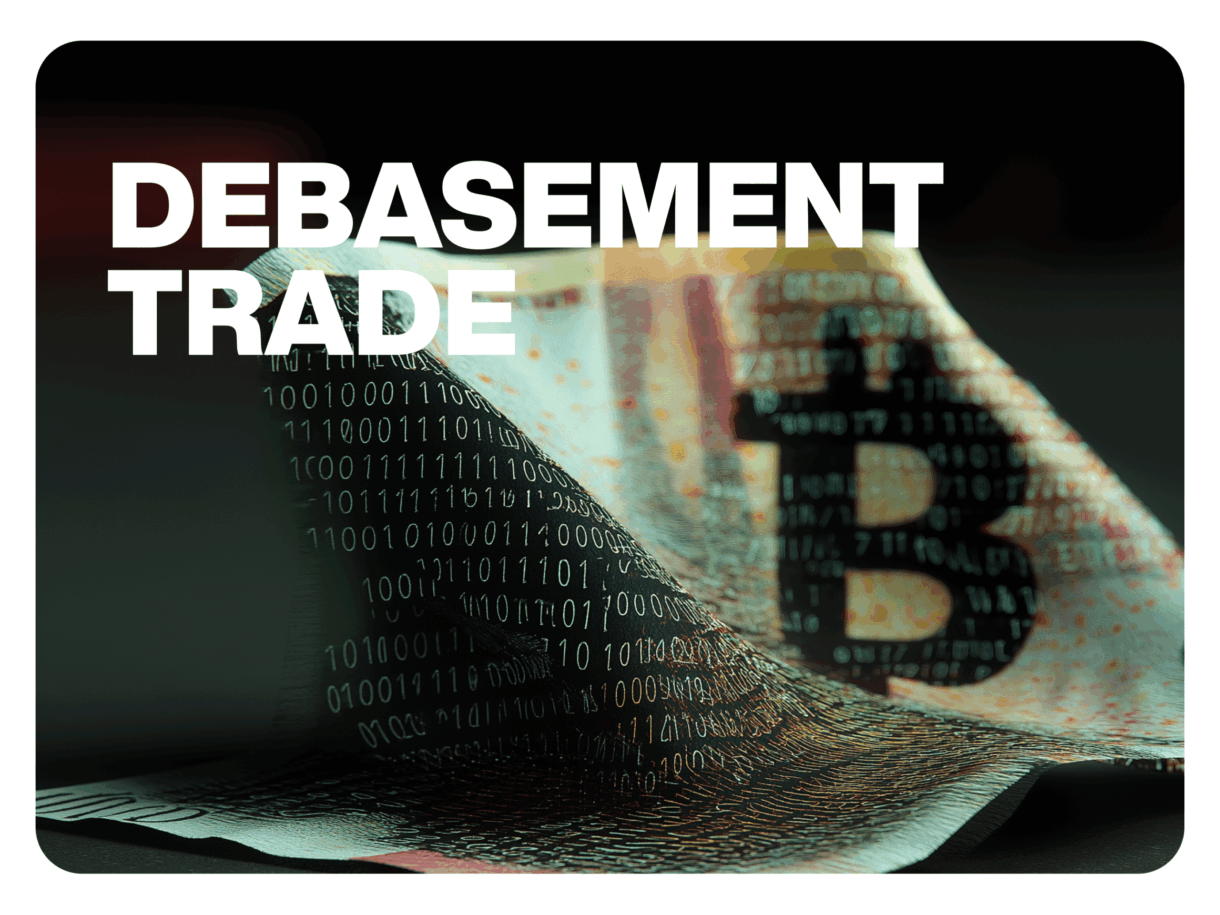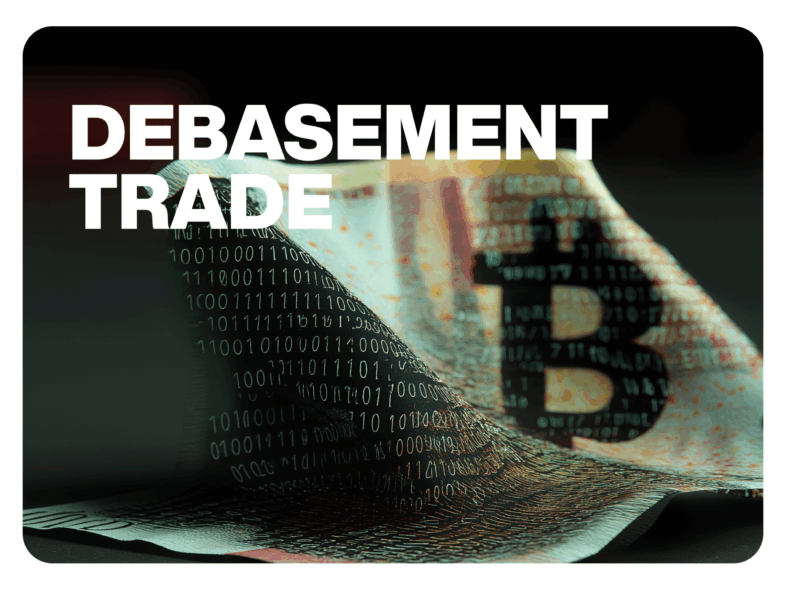The “debasement trade” describes an investment strategy for protecting against the creeping devaluation of money. Global debt grows faster than economic output, central banks flood markets with liquidity, and the purchasing power of national currencies declines.
In what follows, you’ll learn how debasement works, why this trend is expected to accelerate in 2026, and what role Bitcoin plays in it.
What is debasement?
Debasement refers to the devaluation of a currency when the money supply grows faster than real economic output. When new money is created, the same value is distributed across more units, and each unit loses purchasing power. The Roman Empire reduced the silver content of coins to finance the state, leading to rising inflation and a loss of confidence in the currency.
Global debt is at a historic high. Governments cover budget deficits by creating new money, while the purchasing power of the Euro, the Dollar, and other fiat currencies continues to decline.
The debasement trade explained
The debasement trade describes an investment strategy where capital flows into assets that cannot be arbitrarily multiplied. The goal is to preserve value when fiat currencies lose trust. Gold, silver, and real estate have historically filled this role because their scarcity provides stability.
Bitcoin has expanded this circle in recent years. With its fixed cap of 21 million coins, it provides digital protection against monetary devaluation. Institutional investors are adopting this idea. JPMorgan has referred to Bitcoin in analyses as a central element of this strategy because it is constructed to be independent of state control and inflation-resistant.
Why the debasement trade matters in 2026
Global government debt has reached new records, while central banks continue to pursue expansive monetary policies. The money supply is growing significantly faster than the production of real goods and services.
The US Dollar is losing trust. The United States’ high debt burden weakens its position, while Europe struggles with structural problems and strained fiscal policy. Investors worldwide are looking for alternatives that offer protection against inflation and currency depreciation.
Bitcoin in the debasement trade
Bitcoin fundamentally differs from traditional currencies. Its quantity is limited, the network is decentralized, and independent of political decisions. There will never be more than 21 million Bitcoins. This mathematically fixed scarcity makes it a store of value in times of expansive monetary policy.
Bitcoin offers practical advantages. It can be sent globally, divided into tiny units, and traded without intermediaries. A transaction takes minutes, regardless of whether it occurs within Europe or across continents.
Institutional acceptance is increasing. Companies like MicroStrategy now hold large Bitcoin reserves, and with Bitcoin ETFs in the USA, access for traditional investors has become easier. These developments strengthen Bitcoin’s role as a digital counterpart to gold.
Bitcoin vs. traditional safe-haven assets
For centuries, gold was the classic hedge against inflation. It is rare, physically tangible, and globally recognized. Bitcoin takes on the same function in digital form. It requires no storage, no transport, and no middlemen. A hardware wallet, or a mnemonic of 12 words, is enough to securely store large amounts of value.
One Bitcoin consists of 100 million Satoshis, allowing even small investors to invest amounts far below the price of a whole coin. Every transaction is publicly traceable, making manipulation difficult and building trust.
How to enter the debasement trade with Bitcoin
Entry is straightforward. With the Relai app, you can invest in Bitcoin starting from 50 Euros. It was developed for the European market and allows you to buy and securely store Bitcoin.
Relai functions as a non-custodial wallet: you retain control over your private keys; no one else has access to your coins. Only those who possess the keys are the owners of their Bitcoin.
For long-term wealth accumulation, a savings plan works well. With regular purchases—weekly or monthly—you smooth out price fluctuations and use the cost-average effect. This way, you gradually build a position without being guided by daily price movements.
Risks and considerations
Bitcoin is volatile. Its price can fluctuate sharply, especially in short periods. Those who consider Bitcoin as protection against currency debasement should think long-term and be patient.
Only invest amounts that you can hold for several years. Bitcoin is not suitable for short-term speculation or as an emergency fund. Secure storage is crucial. Keep your recovery phrase—the 12 words of your wallet—on paper in a protected place and never share it. This ensures that your Bitcoin remains accessible in the future.
The role of Bitcoin in a portfolio
Bitcoin can be a complementary building block in a diversified portfolio. Many financial analysts recommend holding a small to medium Bitcoin allocation to benefit from its asymmetric risk-reward profile.
The debasement trade focuses on preserving long-term value. In the past 15 years, Bitcoin has shown significant appreciation despite strong fluctuations. Investors who got in early and remained patient profited from sustained growth.
Why now may be a favorable time
Macroeconomic trends point to ongoing currency debasement. Debts, deficits, and money creation continue to increase, while confidence in state-backed currencies declines. Bitcoin is becoming increasingly accessible through regulation, infrastructure, and acceptance.
The longer governments pursue expansive monetary policies, the more attractive scarce digital assets become. Those who start today position themselves early in a market that will gain long-term importance.
Final thoughts
The debasement trade responds to structural weaknesses in the financial system. Fiat currencies lose value, while scarce, decentralized assets like Bitcoin offer stable alternatives. With its fixed cap, global accessibility, and independence from central banks, Bitcoin fulfills the central criteria of a modern store of value.
For investors who want to protect their wealth from loss of purchasing power, Bitcoin offers a real option. The Relai app makes access easy: download, invest, and self-custody. This turns theory into lived practice—step by step, with full control over one’s own money.
FAQs
What is the debasement trade?
An investment strategy where capital flows into scarce assets like gold, silver, or Bitcoin to offset value losses due to inflation.
Why is Bitcoin good for the debasement trade?
Its quantity is limited to 21 million coins, and it operates independently of political decisions. These properties protect against monetary devaluation.
How do I start with Bitcoin in the debasement trade?
The Relai app enables investments starting from 50 Euros and offers secure, self-custodied storage. A savings plan facilitates regular investing over longer periods.
Is Bitcoin safer than gold?
Both assets have advantages. Gold is physical and established, while Bitcoin is digital, portable, and divisible. Many investors combine both to cover different risks.
What are the risks of the debasement trade with Bitcoin?
The Bitcoin price fluctuates sharply. Those who invest long-term and securely store their wallet can better withstand this volatility.
Disclaimer: Relai is authorized to provide crypto-asset services in Switzerland and across the European Union under the MiCA regulatory framework. The company is actively expanding its services to EU member states following the completion of passporting notifications.





